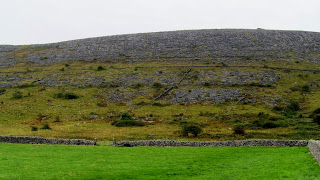The B&B we stayed in last night, The Shores Country House, is advertised as a romantic get-away destination with bedrooms decorated “Laura Ashley style”. That pretty well sums it up. There was nice landscaping and the home was thoroughly modern. Our hostess was ALL dressed up, including strands of beads, as she prepared our breakfast. I cannot say that I have seen that before! Oh, yes, she probably gave us more “misinformation” than anyone did on our trip.
The Shores Country House
We headed out early because we had a long day planned. We wanted to cover both the Dingle Peninsula
and the famed Ring of Kerry. Our first
“Ahhh” for the day was the drive up Connor Pass, the highest pass in Ireland at
1500’ above sea level. The scenery was
both serene and spectacular as we climbed.
Weather had turned nice, so the views were incredible. The countryside got more rugged as green fields
down low turned to rocky hillsides with sparse vegetation. We stopped at a small waterfall along the way
to view the scenery and to watch sheep grazing nearby.
Driving up to Connor Pass, County Kerry
We passed by the ancient Iron Age Fort Dunbeg and took
pictures of a 170-year old stone building that serves as a visitor center and
café at that location. It really was a
unique structure.
Stone Building at Fort Dunbeg
A little further along we stopped at a Fahan Group of “beehive
huts” known as Caher Conor. This group
of five small stone structures was within an enclosed space, denoting one
family likely inhabited it. The huts
were inhabited from ancient times to 1200 A.D. The structures were round like a beehive and
the stones were laid in the form of a circle with each layer laying a little
closer to the center than the one beneath.
Only a small opening is left at the top, which can be closed with a
single small flagstone or capstone. There
was no mortar used in the buildings and the stones have a downward and outward
tilt to shed water. We continued to be
amazed at the ingenuity displayed by both the ancient people and later
generations in how they constructed stone structures through the centuries in
Ireland.
Beehive Hut
Interior showing capstone
Richard
We continued our drive around the Dingle Peninsula to Slea Head,
which is the western-most point in Europe.
The drive along the south side of the peninsula continued to reveal more
wonderful sights as we rounded each bend or came over the crest of each hill. This drive was beautiful in all respects!
Dingle Peninsula, County Kerry
Monument along the road at Slea Head
Slea Head Drive, Dingle Peninsula, County Kerry
Leaving the Dingle Peninsula, we drove immediately onto the
Iveragh Peninsula and the famous Ring of Kerry drive. This, too, proved to be a beautiful drive
with rugged mountains, beautiful valleys with emerald pastures, scenic seaside
villages, and a coastline with cliffs falling into the sea. Wildflowers were in bloom on both peninsulas
making hillsides a sea of color—mostly yellow and pink.
Ring of Kerry drive, Iveragh Peninsula, County Kerry
A couple of "local residents"
We did not make as many stops on this drive because
there were not as many ancient sites to visit along the road as on the Dingle
Peninsula. We planned to tour Derrynane
House, the family home of Daniel O’Connell, but it was closed for
restoration. The walk through the
subtropical gardens from the parking area to the house provided a much-needed
stretch break. O’Connell is known in the
Republic of Ireland as The Great Liberator, the foremost campaigner for
Catholic emancipation, and is highly revered in the country. We closed the day’s touring by driving inland
on the peninsula through Killarney National Park on our way to Killarney where
we spent the night. The park had
beautiful views and is an area I would liked to have had more time to explore.
Killarney National Park
FAST FACTS: Of nearly
4.6 million residents, about 3.7 million (approximately 80%) in the Republic
identify themselves as Roman Catholic. This
is followed by 3% identifying as Protestant, 0.5% Muslim, and the rest an
assortment of other beliefs including none at all. In North Ireland (population approximately 1.8
million) the breakdown is about 53% Protestant and 44% Catholic, with about 3%
other or no religion. Most Irish
Protestants belong to the Church of Ireland, an offshoot of the Church of
England, and the Presbyterian and Methodist churches.
The Catholic Church’s influence has gone down
dramatically, especially since the turn of the century. Most young people see it as irrelevant and
out of step with the major social issues of the day. Many older residents have felt betrayed by
the Church’s handling of child abuse cases, which has resulted in questioning
their lifetime of devotion to local parishes.





































